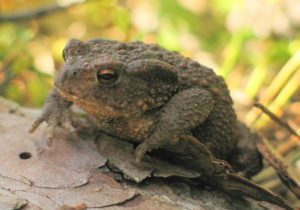A species protected by the Habitat Directive (Annex IV).
Agile frogs are great jumpers worthy of their name, since they can jump up to a distance of two metres.
Amphibians
The clear drop in biodiversity that affects many environments is creating increasing problems for conservation, and amphibians are among the animals that have been most affected by changes over the decades. One of the largest causes is the fragmentation and reduction of habitats, with significant consequences for the breeding sites of these species. Added to this are the introduction of fish even in small lakes, wetland reclamation, and numerous road investments.
In the peat bogs, amphibians can be found only in areas with shallow water, inaccessible to the various predatory fish. Species found in the Reserve include the rare and protected Italian Agile Frog (Rana latastei), the Italian Tree Frog (Hyla intermedia), more common in the ‘Lamette’, and the Italian crested newt (Triturus carnifex). Small but specific interventions to protect these species are being implemented by the managing body through the creation of small ponds.


Italian Agile Frog
An endemic species of the Po Plain, it is classified in the group of red frogs. Protected both nationally and internationally (Annex II of the Habitat Directive), so its conservation is a priority.

Italian crested newt
A species protected by the Habitat Directive (Annexes II and IV).
The largest crested newt present in Italy, it can grow up to 15 cm in length. It is mainly threatened by the loss of its reproductive habitat due to the intensification of agriculture.

Common Toad
A species protected by Regional Law 10/2008.
This is the largest native anuran (tailless amphibian) in Europe.

Italian Tree Frog
A species protected by Regional Law 10/2008.
This small amphibian is part of the Hyilidae family.

Green Frog
Encompassing multiple species, ‘green frog’ implies a set of difficult-to-distinguish species that include the pool frog (Pelophylax lessonae), the edible frog (Pelophylax esculentus), and the marsh frog (Pelophylax ridibunda).